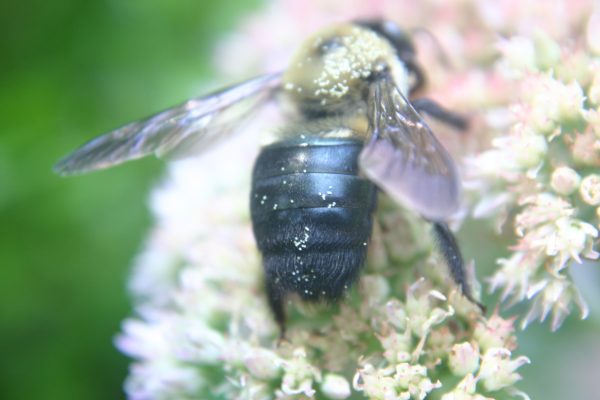Peanut

Arachis hypogaea
Peanuts, sometimes called goober peas, pindars, earth nuts, and ground nuts, are among the richest vegetables for oil content. They grow in a most unique way: When the single-stem, bushy plants are mature, their low-growing branches produce yellow pea-like flowers, from which “pegs” or roots grow from the flower into the soil; pods of nuts form in the ground from the ends of the pegs.
• More detailed information can be found in The Georgia Fruit & Vegetable Book by Walter Reeves and Felder Rushing
• See also Home Garden Peanuts (from Clemson University)
Peanuts are divided into three general categories according to plant and nut types: “Spanish” (bunch) types produce nuts in clusters close to the main stem; “runner” types produce nuts scattered along their low-growing branches from tip to base; and “Virginia” types can be either runner or bunch. Virginia and Runner types, mostly low-growing plants with usually two large seeds per pod, are the best producers for most gardens; Spanish types are mostly erect plants, and produce pods often having three or four small seeds per pod.
WHEN TO PLANT
Peanuts are very sensitive to wet or cold soils. Plant two or more weeks after the last frost, when temperatures have reached the upper 60s or higher.
WHERE TO PLANT
Peanuts grow best in hot, sunny gardens on coarse-textured, sandy loam soils; on fine-textured soils they are difficult to harvest and many pods are left in the ground. Peanuts, being legumes, do not need a lot of nitrogen fertilizer; however, they love calcium and are very sensitive to low pH levels, and should be limed at planting to increase both the soil alkalinity and calcium content.
HOW TO PLANT
Using one-half pound of seed per 100 feet of row, carefully remove seeds that are still in pods, being careful to not damage the seed coat or split the seed. Place seed 2 or 3 inches apart on a wide, slightly-raised bed with rows two feet apart, and cover them with 1-1/2 or 2 inches of coarse soil (1 inch is plenty on fine-textured soils). Where peanuts or southern peas were not grown the year before, buy a fresh commercial peanut inoculamt (at a garden supply store) and mix with the seed immediately before planting.
CARE AND MAINTENANCE
Because peanut plants are low-growing and multi-branched, close cultivation is difficult. Keep weeds under control early on, but do not throw soil up to plants during cultivation as this can cause stem diseases and bury flowers. As the crop grows, hand-cultivation is the best way to go. Peanuts plants are very tolerant of dry soils; however, a weekly good soaking is important during vigorous flowering and when pegs are entering the ground.
For good development of well-filled nuts, an adequate supply of calcium must be available in the pegging zone; when plants begin to flower and peg, sprinkle a light application of gypsum or basic slag over the rows. Do not water as harvest approaches, or risk seed sprouting.
ADDITIONAL INFORMATION
About two months after the plants bloom, leaves will begin to turn yellow. Test for harvest time by digging a few peanuts and checking the inner hulls – when most of them are brown, dig the entire plants using a turning fork, being careful to break off as few pods as possible. Freshly-dug peanuts are excellent for boiling; for drying for later use, move plants to a warm, airy place for two or three weeks to complete curing before pulling nuts from the plants.
If caterpillars, aphids, and grubs are a problem, check with your county extension service office for recommendations on approved garden insecticides.
VARIETIES
Comments (all peanuts take at least four months to harvest).
Florigiant
Virginia type
Florunner
Runner type; most commonly-grown variety
Sunrunner
Similar to Florunner, with slightly larger and more uniform pod and seed
Starr
Spanish type, earlier maturing than most others (about 120 days)
Valencia
Popular small-seeded variety, 3-4 seed per pod
RECIPE
Home-made peanut butter
Note: Roast shelled raw peanuts on a pan one layer deep in a 350 degree oven for 15-20 minutes (20-25 minutes if peanuts still in shells). Remove from heat just short of desired doneness, as peanuts continue to cook as they cool. Season to taste with salt, seasoned salt, garlic salt, etc.
Home-made peanut butter is easily made in a food processor. Simply put two cups of roasted shelled peanuts (with or without red skins), and 1/2 teaspoon salt, and process 2 or 3 minutes using the metal blade. The ground peanuts will form a ball which will slowly disappear. If necessary, stop the machine and scrape sides with a rubber spatula. Yields 1 cup of smooth peanut butter. For crunchy peanut butter, mix in a half a cup of chopped cooked peanuts. Store in the refrigerator. If oil rises to the top, stir before using.















